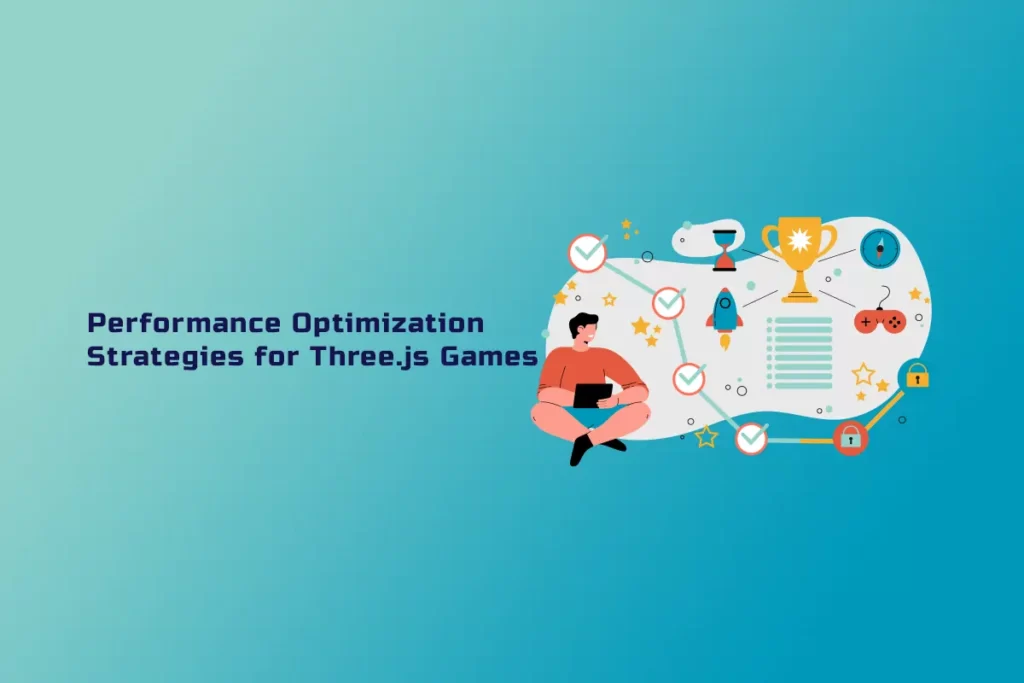Creating captivating games using Three.js is a thrilling adventure for developers. But as the game’s complexity ramps up, focusing on peak performance is vital, ensuring gamers get a silky-smooth and immersive gaming experience. This article will guide you through several performance optimization strategies for your Three.js game development projects.
These strategies will assist you in forging top-tier games that operate effortlessly on various devices and platforms. Check out our earlier blog post for more useful tips on Three.js game development.
Smart Asset Loading
The key to improving game performance starts with intelligent asset loading and management. Here are a few techniques to consider:
Compressing Assets
Use tools like Draco for mesh compression and Basis Universal for texture compression to streamline your assets without losing visual integrity.
Texture Atlases
Merging multiple textures into a single texture atlas minimizes draw calls and improves rendering speed. Tools like TexturePacker can do the heavy lifting for you, generating optimized atlases.
Level of Detail (LOD)
With LOD techniques, you can render less complicated models when objects are far off or take up tiny screen space, reducing polygon count and boosting performance.
Effective Rendering
Keeping the rendering performance in check is vital for a smooth frame rate. Here’s how:
Frustum Culling
This technique stops rendering objects outside the camera’s view frustum, saving unnecessary calculations and rendering, thus enhancing performance.
Occlusion Culling
This method removes from rendering those objects hidden by others. Rendering only visible objects can result in substantial performance leaps.
Shader Optimization
Refining shaders can significantly impact performance. Simplify complex shader code, minimize texture lookups, and cut unnecessary calculations for optimal rendering speed.
Masterful Memory Management
Good memory management is key to avoiding memory leaks and excessive memory use, especially when adding AI and Machine Learning features in Three.js games. Here are some good practices:
Dispose of Unused Resources
Free up memory by removing unneeded textures, geometries, materials, and render targets. Three.js provides the dispose() method for this.
Object Pooling
Use object pooling for objects frequently created and destroyed, like bullets or particles. This method minimizes memory allocation overhead and enhances performance.
Garbage Collection Optimization
Limit the creation of temporary objects within game loops, as excess garbage collection can cause performance glitches. Reuse objects whenever possible.
Performance Profiling
Profiling your game helps spot performance bottlenecks and areas needing optimization. Try these techniques:
Browser Developer Tools
Leverage developer tools offered by modern browsers to spot CPU-intensive tasks, memory use, and rendering bottlenecks.
Stats.js
The Stats.js library provides a light performance monitor that shows FPS, memory use, and live rendering info.
Custom Performance Metrics
Develop custom metrics to measure your game’s performance-critical aspects. For example, track the time taken for crucial calculations or rendering tasks and optimize accordingly.
Mobile Optimization
Optimizing Three.js games for mobile devices is a must to reach a wider audience. Keep these mobile-specific strategies in mind:
Touch Controls
Design intuitive touch controls that need minimal complex gestures or excessive touch inputs. Streamline the user interface and touch event handling for smoother gameplay.
Device Detection
Figure out the capabilities of the device running your game and tweak quality settings as needed. Lower texture resolutions cut the number of particles or simplify shaders for better performance on mobile devices.
Performance Testing
Regularly test your game on various mobile devices and performance testing tools to ensure optimal performance across different devices and screen sizes.
Animation Optimization
Smooth and engaging animations are the key for a top-notch 3d gaming experience. Optimize using these techniques:
Animation Caching
Pre-calculate and cache complicated animation sequences to bypass unnecessary calculations during runtime. This tactic reduces CPU overhead and improves performance.
Delta Timing
Apply delta timing for frame-rate independent animations. This method ensures consistency in animations across different frame rates by considering the time passed since the last frame.
Animation Blending
Smooth transitions between animations improve visual quality and maintain performance. Animation blending minimizes sudden changes.
Code and Logic Optimization
Streamlining the underlying code and game logic can significantly boost performance. Here are some strategies:
Algorithmic Efficiency
Scrutinize and refine crucial algorithms within your game. Identify potential bottlenecks and seek alternate algorithms or data structures for performance enhancement.
Batch Rendering
You can reduce overhead and boost rendering performance by grouping render calls.
Event Handling
Optimize event handling by reducing the number of event listeners and applying event delegation. This approach cuts memory consumption and enhances responsiveness.
GPU Acceleration
Leveraging the GPU can significantly boost the performance of Three.js games. Keep these techniques in mind:
WebGL Extensions
WebGL extensions offer extra features and capabilities that can be used to enhance rendering performance. Explore extensions like WEBGL_compressed_texture_s3tc and WEBGL_draw_buffers for optimizing texture compression and multiple render target operations.
Shader Compilation
Precompile shaders and cache them for reuse to save runtime shader compilation overhead. This tactic wipes out the performance hit caused by dynamic shader compilation during gameplay.
Performance Optimization for Physics Simulations
Physics simulations often play a vital role in games. Optimizing these calculations can lead to overall performance boosts. Here’s how:
Collision Detection
Enhance collision detection algorithms using techniques such as spatial partitioning (e.g., bounding volumes or grids) to minimize collision checks. This method reduces the computational load and enhances performance.
Simplify Physics Calculations
: Streamline physics calculations by using approximations or decreasing the complexity of physical interactions.
Balancing accuracy and performance is crucial, especially when complex physics simulations aren’t critical to the gaming experience.
Wrapping Up
Optimizing the performance of Three.js games is critical for delivering a mesmerizing gaming experience.
You can ensure your games run smoothly on different platforms and devices by adopting efficient asset loading, rendering techniques, memory management strategies, performance profiling tools, mobile optimization methods, animation optimization, code and logic optimization.
As a leading Three.js game development company, we offer complete solutions tailored to your needs. From idea to design, coding, and optimization, our team guarantees your audience a seamless and immersive gaming experience. Let’s bring your game vision to life!



